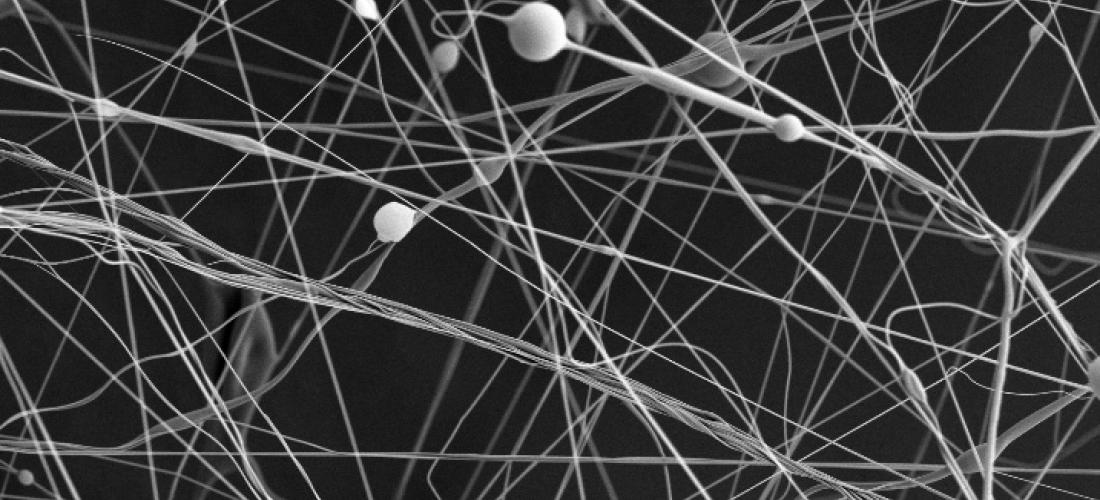ETSi professors discover a method for the mass production of microfibers
ETSi professors discover a method for the mass production of microfibers
Professors from the Department of Aerospace Engineering and Fluid Mechanics of the Higher Technical School of Engineering of the University of Seville achieve a method for mass production of microfibers made with a polymer called polyvinyl alcohol (PVA). This study, collected in the article https://doi.org/10.1039/D3RA03070A , presents a quantitative advance regarding the possibility of industrially producing nanofibers.
Professors Luis Modesto López and Alfonso Gañán Calvo, together with the student Jesús Olmedo Pradas, present in this article this new technology, which can be applied to the mass production of micro and nanomaterials, particularly nanofibers. “Due to the high processing capacity, the technique we propose could, in the future, be scaled up and adapted to industrial production, thereby improving production ratios. Furthermore, it must be taken into account that it is a technique for producing polymer fibers and these materials are present in practically all aspects of daily life, so its application is truly wide and diverse: manufacturing of so-called scaffolds biocompatible for use in tissue regeneration, the production of fibrous platforms for energy generation and storage systems (ie, electrodes), 3D printing systems. Other of the most visible and currently relevant industrial applications would be the manufacturing of materials for masks and PPE or for the so-called “Smart wearables” (“intelligent fabrics”),” says Professor Modesto López.
The relevance of this work lies in the mass production of very thin fibers, known as microfibers, and made of a polymer called polyvinyl alcohol (PVA). To do this, they use a unique process with which, with a single injector, they have the capacity to process a thousand times more microfibers than with conventional systems, such as so-called electrospinning or “electrospinning”. These microfibers have a diameter of less than 1 micrometer (1 micron, one millionth of a meter), between 0.9 and 0.5 microns, which means they are much thinner than a human hair (100 microns) or a red blood cell (8 microns). ). They can even be as thin as the coronavirus (less than 0.5 microns).
The study aimed to develop a simple but robust technology to produce micro- and nanofibers using Flow Blurring® type pneumatic injectors (provided by Ingeniatrics Tecnologías SL). These devices use a current of air to fragment a liquid flow, giving rise to the formation of fine droplets (such as those generated by terrace sprinklers), a process known as spraying. It is important to note that our study was funded with funds from the PAIDI 2020 and FEDER programs.
Professor Modesto López tells how they came to this discovery in this way: “The research began with spraying tests in which the production of microdroplets was sought. However, instead, we got elongated structures that we call ligaments. When studying the underlying physics of the spraying process, we realized that ligaments were formed by using highly viscous liquids with a certain viscoelasticity. However, a method was needed to solidify the ligaments and obtain fibers. Therefore, we resorted to a heat source, in this case a tubular oven capable of reaching temperatures of up to 1200 degrees Celsius, although in our study 300 degrees were sufficient. In summary, we spray a polymer solution into the oven using a Flow Blurring injector. The heat generated by the oven allowed rapid drying of the ligaments, resulting in the formation of microfibers in a matter of seconds. Likewise, in parallel we perform computational fluid dynamics (CFD) simulations to better understand the physical processes that govern the fragmentation of polymer solutions and the formation of ligaments.”
Most of the work was carried out in the Fluid Mechanics laboratory, in the Department of Aerospace Engineering and Fluid Mechanics of the ETSI, although they also made use of the CITIUS facilities, where they analyzed the viscosity of the polymer solutions in the Functional Characterization and we examine the shape and size of the microfibers using a scanning electron microscope (SEM) from the Microscopy unit.
The project is transformative in that it aims to revolutionize conventional methods of producing micro- and nanofibers. Currently, the most common techniques for manufacturing nanofibers use electric fields as a source of energy to “stretch” polymer solutions, reduce their size and/or fragment them; but it requires that the liquid have a certain electrical conductivity. Furthermore, these techniques have a low processing capacity of the solution in question, of the order of 0.1 milliliters per hour. In this sense, our technology is more energetically efficient than current methods since it does not depend on an external energy source to fragment the liquid, but rather takes advantage of the mechanical energy contained in the air stream to generate a new surface, that is, a multiplicity of thinner ligaments. Likewise, the proposed technology has a very high processing capacity since it can operate with liquid flow rates of the order of 1500 milliliters per hour, this is more than a thousand times the capacity of conventional systems. Likewise, this project opens a new line of research related to the manufacture of composite fibers that consist of two or more polymeric materials and that in turn may contain functional nanoparticles or materials such as graphene and carbon nanotubes.
